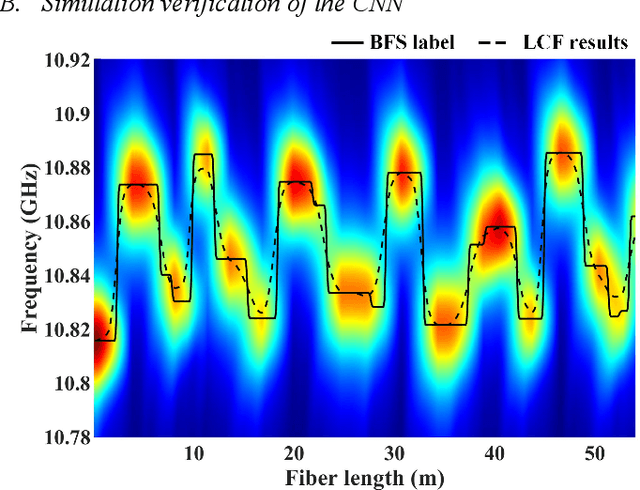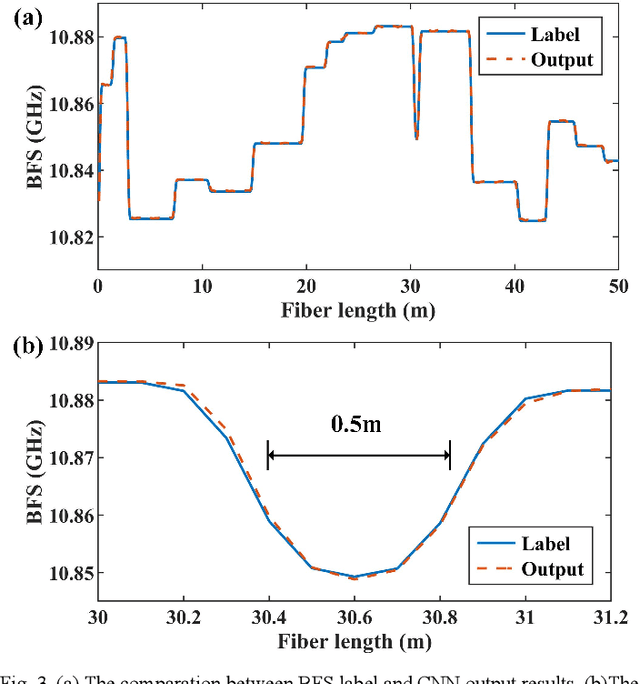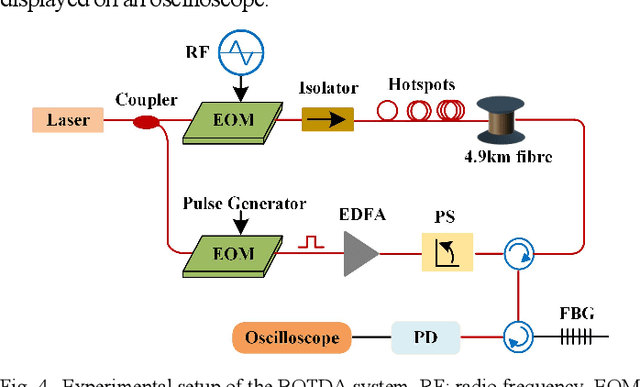Zhao Ge
Real-Time Distributed Optical Fiber Vibration Recognition via Extreme Lightweight Model and Cross-Domain Distillation
Jul 28, 2025Abstract:Distributed optical fiber vibration sensing (DVS) systems offer a promising solution for large-scale monitoring and intrusion event recognition. However, their practical deployment remains hindered by two major challenges: degradation of recognition accuracy in dynamic conditions, and the computational bottleneck of real-time processing for mass sensing data. This paper presents a new solution to these challenges, through a FPGA-accelerated extreme lightweight model along with a newly proposed knowledge distillation framework. The proposed three-layer depthwise separable convolution network contains only 4141 parameters, which is the most compact architecture in this field to date, and achieves a maximum processing speed of 0.019 ms for each sample covering a 12.5 m fiber length over 0.256 s. This performance corresponds to real-time processing capabilities for sensing fibers extending up to 168.68 km. To improve generalizability under changing environments, the proposed cross-domain distillation framework guided by physical priors is used here to embed frequency-domain insights into the time-domain model. This allows for time-frequency representation learning without increasing complexity and boosts recognition accuracy from 51.93% to 95.72% under unseen environmental conditions. The proposed methodology provides key advancements including a framework combining interpretable signal processing technique with deep learning and a reference architecture for real-time processing and edge-computing in DVS systems, and more general distributed optical fiber sensing (DOFS) area. It mitigates the trade-off between sensing range and real-time capability, bridging the gap between theoretical capabilities and practical deployment requirements. Furthermore, this work reveals a new direction for building more efficient, robust and explainable artificial intelligence systems for DOFS technologies.
Real-time Event Recognition of Long-distance Distributed Vibration Sensing with Knowledge Distillation and Hardware Acceleration
Aug 07, 2024Abstract:Distributed optical fiber vibration sensing (DVS) technology based on phase-sensitive optical time-domain reflectometry is widely used for safety monitoring and intrusion event surveillance in wide-ranging fields. Existing methods rely on deep learning models for event recognition but struggle with real-time processing of large data volumes in long-distance applications. To address these challenges, we use a four-layer convolutional neural network (CNN). The application of knowledge distillation with ResNet as the teacher model improves the generalization ability of the four-layer CNN, increasing the accuracy from 83.41% to 95.39% on data from untrained environments. The model is implemented on a field programmable gate array (FPGA) using a novel design that replaces multiplication with binary shift operations and quantizes model weights accordingly, allowing for high parallelism and low latency. An inference time of 0.083 ms is achieved for a spatial-temporal sample with a 12.5 m fiber length and 0.256 s time frame. This implies the system can process signals over a fiber length of approximately 38.55 km in real time, which is more than twice the capability of a GPU of Nvidia GTX 4090. The proposed method greatly improves the efficiency of vibration pattern recognition, thus promoting the application of DVS as smart sensing system in various areas. The data and code is available at https://github.com/HUST-IOF/Efficient-DVS
Real-time FPGA Implementation of CNN-based Distributed Fiber Optic Vibration Event Recognition Method
Aug 09, 2023Abstract:Utilizing optical fibers to detect and pinpoint vibrations, Distributed Optical Fiber Vibration Sensing (DVS) technology provides real-time monitoring and surveillance of wide-reaching areas. This field has been leveraging Convolutional Neural Networks (CNN). Recently, a study has accomplished end-to-end vibration event recognition, enabling utilization of CNN-based DVS algorithms as real-time embedded system for edge computing in practical application situations. Considering the power consumption of central processing unit (CPU) and graphics processing unit (GPU), and the inflexibility of application-specific integrated circuit (ASIC), field-Programmable gate array (FPGA) is the optimal computing platform for the system. This paper proposes to compress pre-trained network and adopt a novel hardware structure, to design a fully on-chip, pipelined inference accelerator for CNN-based DVS algorithm, without fine tuning or re-training. This design allows for real-time processing with low power consumption and system requirement.An examination has been executed on an existing DVS algorithm based on a 40-layer CNN model comprising 2.7 million parameters. It is completely implemented on-chip, pipelined, with no reduction in accuracy.
Enabling variable high spatial resolution retrieval from a long pulse BOTDA sensor
Sep 09, 2021



Abstract:In the field of Internet of Things, there is an urgent need for sensors with large-scale sensing capability for scenarios such as intelligent monitoring of production lines and urban infrastructure. Brillouin optical time domain analysis (BOTDA) sensors, which can monitor thousands of continuous points simultaneously, show great advantages in these applications. We propose a convolutional neural network (CNN) to process the data of conventional Brillouin optical time domain analysis (BOTDA) sensors, which achieves unprecedented performance improvement that allows to directly retrieve higher spatial resolution (SR) from the sensing system that use long pump pulses. By using the simulated Brillouin gain spectrums (BGSs) as the CNN input and the corresponding high SR BFS as the output target, the trained CNN is able to obtain a SR higher than the theoretical value determined by the pump pulse width. In the experiment, the CNN accurately retrieves 0.5-m hotspots from the measured BGS with pump pulses from 20 to 50 ns, and the acquired BFS is in great agreement with 45/40 ns differential pulse-width pair (DPP) measurement results. Compared with the DPP technique, the proposed CNN demonstrates a 2-fold improvement in BFS uncertainty with only half the measurement time. In addition, by changing the training datasets, the proposed CNN can obtain tunable high SR retrieval based on conventional BOTDA sensors that use long pulses without any requirement of hardware modifications. The proposed data post-processing approach paves the way to enable novel high spatial resolution BOTDA sensors, which brings substantial improvement over the state-of-the-art techniques in terms of system complexity, measurement time and reliability, etc.
 Add to Chrome
Add to Chrome Add to Firefox
Add to Firefox Add to Edge
Add to Edge